Abstract
The attributes of the athletes’ behaviour occur if the teacher has conducted an activity according to the coaching principles. The purpose of the research is to investigate how students perceive their own behaviour, athletes and coaches, and the method used is the questionnaire consisting of 9 items, the last being a construct suggestively called “the wheel of life”. The investigation of the athletes’ motivation level, preferences and autonomy during lessons is a way to highlight the direct effects of coaching mastery in valuing their skills. The athletes’ responses to the applied questionnaire items are feedback reactions to the teacher’s approach of the coaching style. It is difficult to know the motivation of the athletes because, in many cases, the real reasons of some hidden behaviour are not easily revealed. This restraint of the athletes is caused by a wide range of affective processes, especially emotions. This is why the teacher should use indirect means of investigation or other ways which will allow knowing the athlete (insight) and his/her capacity as a person. The last item was conceived as a construct – “the wheel of life” – resulted from sharing the satisfaction level by domain: health, sports career, personal development, fun, physical environment, relationships and more. These come to complete the picture on the level of study (student awareness and accountability in the academic and sports support). It shares a visualization of areas of life. The analysed results show a high degree of assimilation of the interventions through coaching.
Keywords: Coaching, motivation, skills
Introduction
The application of coaching (Dos Santos et al., 2010) and its principles involves feedback from the
subjects, both on the mental and action planes; in the latter case, the motor behaviour highlights the
effects of internalizing the entire process. Observations and statistics focused, on the one hand, on the
quality of technical and tactical actions, the conducting of additional exercises (interest, concentration,
responsibility), and on the other hand, the volume of the activities (repetition, duration, sports results
and the number of games played) (Whitmore, 2004: 37). However, all these are meant to highlight
changes in mental interpretive unity – action.
The perception of the coaching process by the athletes was performed through applications and
theoretical documentation, in this research both actions causing internalization with cognitive
consequences on the behaviour of the athletes (Epuran, Holdevici, & Toniţa, 2001: 246, 269; Dragnea,
2006: 72);
In the process of modelling coaching for the investigated subjects, an important component was the
ability to track the object of the game – the ball, integrated into the previously developed training
model (Lyle, 2004: 61; Teodorescu & Ganera, 2013).
The ending of the visual observation of the ball has adverse consequences on concentration and
accountability, especially in games.
Purpose of the research
The purpose of the research is to investigate how students perceive their own behaviour, athletes
and coaches at the following application guidelines coaching. The image formation and the mentality
on coaching of the athletes (metabolizing on the cognitive and actional planes), and the cognition of the
level at which the assimilation has occurred are also aimed (Dragnea, 2006: 72). In this context, a
methodological guide for teachers enrolled in advanced coaching research and a sample of junior
handball players were included. In this document, the references will be made only to student athletes.
Tasks and methods of the research
1. The development of the methodological guide and its application to junior handball players.
2. The distribution of the guide for reading and actions to encourage the understanding of it.
3. The development of a set of structured questions in a questionnaire applied to students, enabling
them to self-assess the activity.
Guidelines for coaching application to junior handball teams
The principles of coaching:
•Inner game and its role in maximizing performance; •Exploitation of the athletes in relation to their potential; •The principle of awareness; •The principle of accountability; •Making full use of one’s mind.
(Dragnea & Teodorescu, 2002: 543-547)
Ideal, goal and objectives in coaching
Procedural interventions in coaching (formulating the questions)
The work plan of coaching and the context of application
Materials and methods
The research methods used were: bibliographic study, observation, questionnaire survey (Chelcea,
2001: 73, 145). The method used was the questionnaire, through which the perception of the coaching
process by students was investigated and analysed. The questionnaire consists of 9 items, the last being
a construct suggestively called “the wheel of life”.
The investigated sample
20 pupils, athletes, 6 boys – in the 11th grade and 12th grade, and 14 girls in the same grades, with 3-
4 years of experience in handball, members of sports program classes.
Results and discussions
Item 1.In the preparatory work (training), you prefer:
- Total autonomy;
- Partial autonomy;
- Without autonomy.
Chart 1 shows that our sample is within 50% and 50% for total autonomy and partial autonomy.
Half of them want to be ruled by the coaches through suggestions and guidance, compared with the
situation recorded in the first test, when 50% preferred total autonomy (unchanged percentage in the
second test), 25% preferred partial autonomy and 25% without autonomy. Progress says a lot. The
raising of the learning level and mastery induces independent actions.
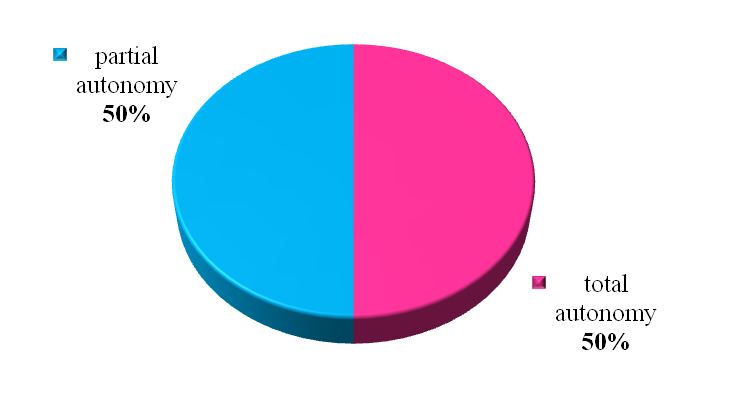
Item 2. In the process of sports training, you are encouraged if
The calculated percentage for the preference to give one’s own idea orally and prove it is 45%
compared to verbal repetition of a given task, which meets 55% of preferences. (Table 1)
Item 3. How do you react to the ideas and the pieces of advice received from your coach?
Belief and confidence meet 95% of reactions (Chart 2), which accredits the awareness of the
training process, compared with the first test, in which the response to the “order” failed to meet the
responses to the second test. The 5 percent must be correlated with the responses to question 1 on the
preference for autonomy.
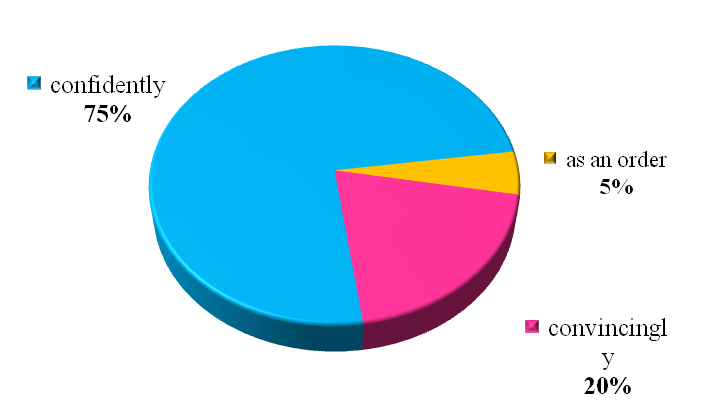
Item 4. The learning of new tasks
Motivation and panic in front of new tasks install depending on the presentation of the task, its
accessibility to a certain level of training, and not least, depending on the state of preparation of the
athlete. Chart 3 shows that motivation is stimulated and the responses to this item should be related to
those under questions 1 and 3 of the questionnaire.
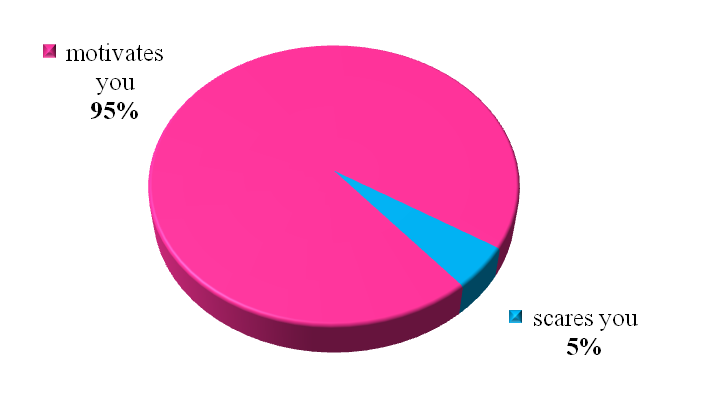
Item 5. What action influences you the most?
The responses of the athletes highlight the reasonableness of the training process conducted in a
favourable affective context. The responses to this question are guidelines for coaches to prepare for
the game and for the situations of interruptions in which the encouragement and the solutions for the
correctors play an important role (Chart 4). The responses to this question will be correlated with the
management of training styles.
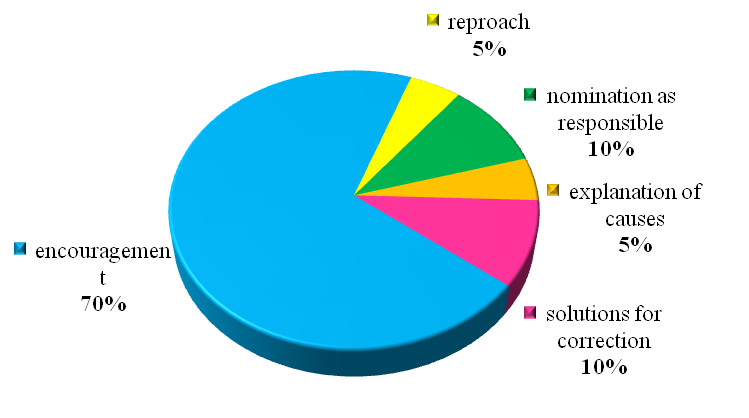
Item 6. Do the coaches ask you to self-assess in training or competitions?
Self-assessment is a process of awareness, understanding and ranking of the athlete. Chart 5
highlights the application of the coaching principle to the activity of the athlete and the exploitation of
his/her abilities.
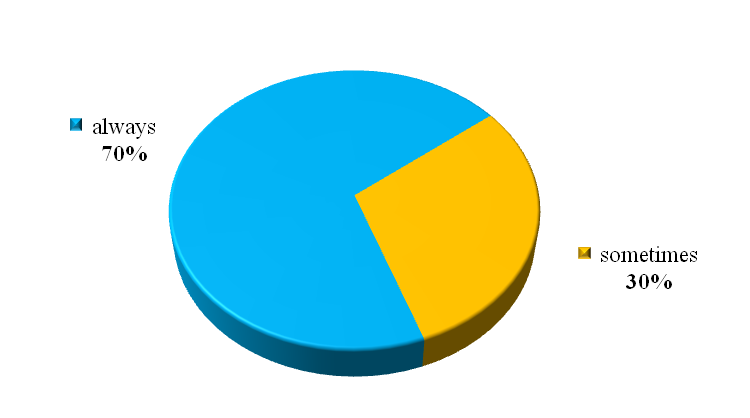
Item 7. Fill in each section of “the wheel of life” with the percentage (up to 100%) corresponding to
the level of current satisfaction in the eight areas.
The highest percentage is recorded by health – 26.5%, which is the conditional factor for the other
areas.
Chart 6 illustrates the important place that sports career and also personal development occupy -
17% and 12%, which attracts and conditions the other areas.
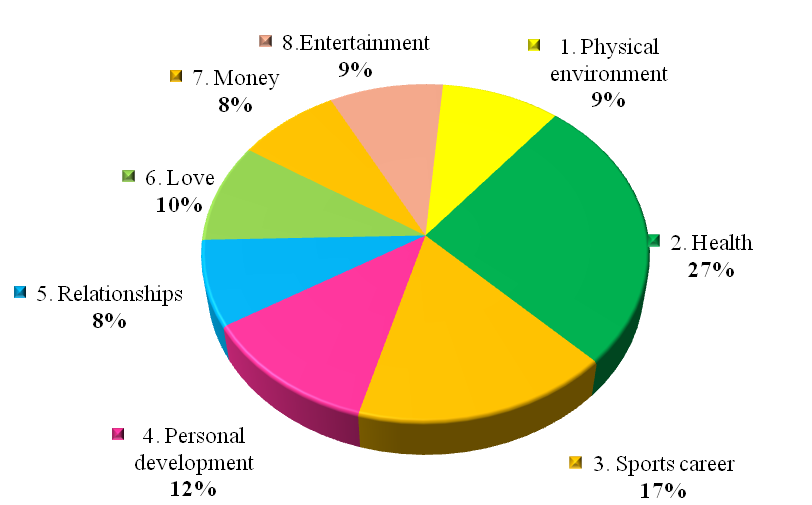
Conclusions
The subjects investigated prefer in equal percentages total autonomy and partial autonomy in
objective lessons through coaching. It is preferred verbal repetition of a given task to the detriment of
verbal presentation of a certain idea. The confidence with which the pieces of advice are received from
the teacher meets 75% of preferences from other forms - conviction and order. New tasks motivate
athletes, 95% of them feel mobilized and encouraged. The importance given to the different areas of
life focuses on health and athletic career, higher goals, which shows maturity, resulting in an
understanding of coaching.
The responses to the questionnaire highlight the awareness of the coaching process and
responsibility in training.
References
Chelcea, S. (2001). Tehnici de cercetare sociologică. București: SNSPA.
Dos Santos, S. F. M., Mesquita, I. M. R., Dos Santos Graca, A. R., & Rosado, A. F. B. (2010). What coaches value about coaching knowledge: A comparative study across a range of domains. International Journal of Applied Sports Sciences, 22(2), 96-112.
Dragnea, A. (2006). Elemente de psihosociologia grupurilor sportive. București: CD-Press.
Dragnea, A., & Teodorescu S. (2002). Teoria sportului. București: FEST.
Epuran M., Holdevici I., & Toniţa F. (2001). Psihologia sportului de performanţă. București: FEST.
Lyle, J. (2004). Sport coaching concepts - A framework for coaches’ behaviour. London and New York.
Teodorescu, S., & Ganera, C. (2013). Teoria și managementul competițiilor sportive. București:
Discobolul. Whitmore, J. (2008). Coaching pentru performanță. București: Publica.
Copyright information

This work is licensed under a Creative Commons Attribution-NonCommercial-NoDerivatives 4.0 International License.
About this article
Publication Date
10 June 2016
Article Doi
eBook ISBN
978-1-80296-010-5
Publisher
Future Academy
Volume
11
Print ISBN (optional)
-
Edition Number
1st Edition
Pages
1-509
Subjects
Sports, sport science, physical education
Cite this article as:
Cristea, D. N. (2016). Reflecting the Coaching Process in Junior Handball Players’ Actional Attitude . In V. Grigore, M. Stanescu, & M. Paunescu (Eds.), Physical Education, Sport and Kinetotherapy - ICPESK 2015, vol 11. European Proceedings of Social and Behavioural Sciences (pp. 431-437). Future Academy. https://doi.org/10.15405/epsbs.2016.06.60

